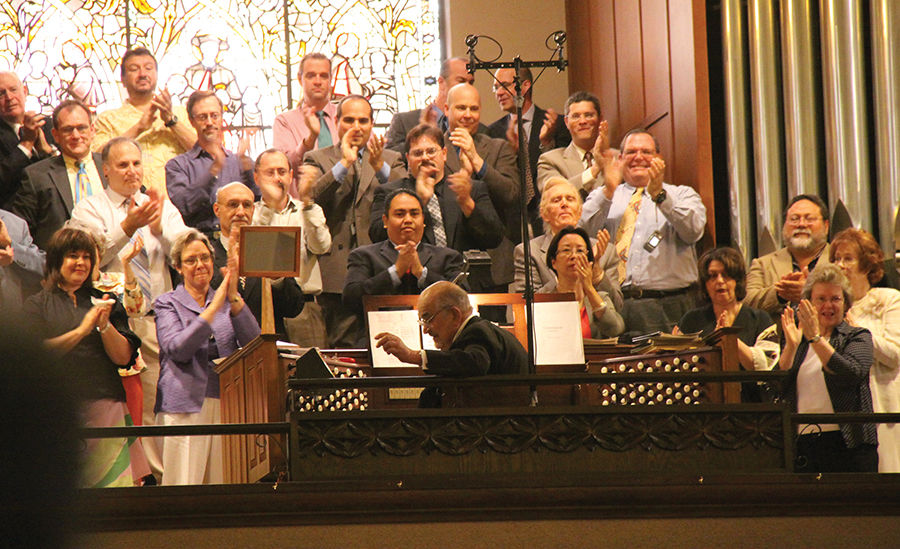A maestro, teacher, Grammy-nominee and mentor to thousands of people who sang in the choirs he led at Mount St. Mary’s, Loyola Marymount, the L.A. Master Chorale and St. Charles Borromeo Church in North Hollywood — where he conducted adult and children’s choruses for 60 years — Paul Salamunovich died peacefully surrounded by love and strains of music April 3.
The internationally-acclaimed choral conductor, whose choirs sang at the Vatican, all over the U.S. and Europe, in more than 100 film and television productions and on many recordings, died at Sherman Oaks Hospital of complications from West Nile virus. He was 86.
Frank Brownstead, director of music at the Cathedral of Our Lady of the Angels, said Salamunovich’s death marked “an end of an era” in Los Angeles, long known as a hotbed for top-notch choral conductors, such as Roger Wagner, founder of the L.A. Master Chorale, Howard Swan and Charles Hurt.
“Paul was in that group and very sought after,” said Brownstead. “He influenced more people than anybody I know.”
Salamunovich’s interest in Gregorian chant and passion for music was nurtured as a child in his native Redondo Beach, where he joined his parish choir at St. James Church as a boy soprano at the age of ten. As a young teen, he met and received musical training from Richard Keys Biggs, then-music director at Blessed Sacrament in Hollywood, a convert whose wife, Lucienne, had studied at Solesmes in France.
“We grew up together, both taught by my mom and dad in the early ’40s,” said Geraldine Biggs McGrath, celebrating her 60th year as liturgy and music director at St. John Baptist de la Salle in Granada Hills.
Recognizing Salamunovich’s musical talent, her father gave the teenage boy free lessons in sight reading, singing and keyboard playing in the tower of Blessed Sacrament Church. At Christmastime, when pastors would frantically call Biggs for singers in the days before many local churches had choirs, he would ask Paul, age 17, to drive over and pick up Geraldine, 15, so they could sing Christmas Mass, sometimes rushing from one parish to another.
“Paul had a real calling for the Catholic liturgy,” said McGrath. “He had his own deep spiritual side.” She recalls he told her upon taking the St. Charles Borromeo Choir to the Vatican to sing at a 1980s service attended by Pope John Paul II, “I couldn’t say one word I was crying so hard.”
Upon his discharge from the Navy in 1946, Salamunovich joined the Los Angeles Concert Youth Chorus, which became the Roger Wagner Chorale two years later. Wagner became a mentor to Salamunovich, who succeeded Wagner as music director at St. Charles in 1949.
Salamunovich was named assistant conductor of the Roger Wagner Chorale in 1953 and, when Wagner created the Los Angeles Master Chorale in 1964, he had his protégée continue in that role until he left to pursue other opportunities. Salamunovich returned to direct the L.A. Master Chorale in 1991, continuing in that capacity for a decade.
Dr. Mary Breden, chair of the LMU Music Department and a student of Salamunovich’s at MSMC, told The Tidings that she learned her craft as a choir conductor while serving as Salamunovich’s piano accompanist at the Mount and LMU. She took his place as director of the Loyola Choruses when Salamunovich went to the Master Chorale.
“Since 1992, carrying the legacy he built here has been a special privilege and responsibility,” said Breden, also a longtime member of Salamunovich’s St. Charles Borromeo Choir, until he retired as director in 2009.
Mary Star of the Sea organist Jelil Romano, who met Salamunovich in the ’70s when he played organ for him occasionally at St. Charles Borromeo, said Salamunovich had a unique choral sound. “His whole choir sounded blended, like one voice,” said Romano.
Nor was Salamunovich afraid of new music. He commissioned Morten Lauridsen to compose a work for the Master Chorale, resulting in a Grammy nomination for the group’s 1988 recording of Lauridsen’s “Lux Aeterna.”
Stephen Salamunovich, one of Salamunovich’s four sons (a daughter, Nanette, died in 1977) said the family, including Salamunovich’s wife of more than 60 years, Dottie, have been overwhelmed by the heartfelt messages of condolences that are pouring in.
“I think he would be very surprised at the full impact he had on people,” said Stephen, who lives in Seattle. “I’ve had people run into me and start weeping at hearing my last name” because of their past association as a student or chorister under Salamunovich or even an audience member or fan.
“There are a lot of people who sang for him who never became musicians,” noted Stephen, “but they were influenced by his dedication to excellence, integrity, and the ideal of never settling for anything less than the best.”
Salamunovich’s Funeral Mass, open to the public, will be celebrated May 3, 10 a.m. at Blessed Sacrament Church. A rosary will be held May 2, 7 p.m., at St. Charles Borromeo Church.

